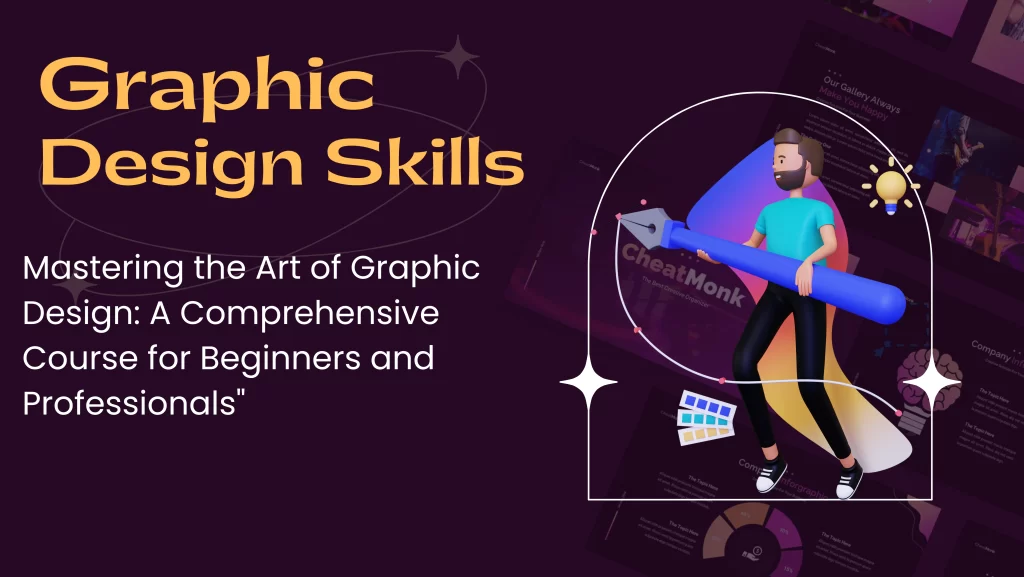
Introductiion:
Graphic Designing Skills in 2023 is a craft where professionals create visual and innovative content to communicate messages. By using visual hierarchy and page layout techniques, designers use typography and pictures to connect with users and their specific needs and concentrate on the logic of displaying elements in interactive designs, to enhance the user’s experience. Although working in a digital age means one should work with interactive software, GraphicDesigning still revolves around old principles. As a graphic designer, one should have a team of people who have a better understanding and knowledge of color theory and the right choice of color scheme. Color choices reflect not only on the organization but also on the client’s expectations. One should design with an eye for how elements match the tone.
The Graphic Designer also need to design for the overall effects and should note how they shape users’ emotions as they guide the from, for instance, a landing page to a call to action. Often, graphic designers are involved in motion design for small screens. The company carefully monitors how its work aesthetics match its user’s expectations. They can enhance their design’s usability in a flowing, seamless experience by anticipating the user’s needs and mindsets. With user psychology in mind, it’s very important to stay focused on some especially weighty graphic design considerations. “Graphic Design takes textual and graphical elements and implements them into multiple types of media”, this is said a famous designer. Graphic design can be used by businesses and companies to promote and sell their products via advertisement, websites to communicate complicated information in a digestible way through infographics, or by businesses to develop an identity through branding, among other things.
Basics of Graphic Designing-
For a better understanding, of the meaning of graphic design, it is important to be aware of the elements and rules that make designs. Elements are used in the same or in opposition to one another to create visually striking and impactful designs. These graphic designs include elements such as-
1. Shape
2. Color
3. Texture
4. Size
5. Form
6. line
7. Space
Graphic Designers adhere to the principles of design, which are essentially a combination of guidelines that help to design the achieve effective composition. These basic principles aid in creating balance and consistency for a part of the work. These graphic design principles include-
Contrast
Proportion
Balance
Emphasis
Rhythm
Movements
Types of Graphic Design-
Graphic Designing is composed of many fields and specializations, beginning from print and web design to animation and ongoing graphics. Graphic design offers opportunities and options for every individual of probably any interest.
Some of the most noticed modern graphic design instances stem from enhancements in technology. A little glimpse of some of the types of graphic design are as follows-
. Website Design involves creating engaging and intuitive web pages for users. This includes overall layouts, color schemes, and navigations.
. Motion Graphics Design also known as animation brings visual elements to life, through extraordinary effects, videogames, TV shows, and movies.
. User Experience (UX) Design is focused on ensuring a website or application is simpler and more satisfying to use. This kind of designer emphasizes usage, values, adaptability, and desire.
Elements of Graphic Design-
Elements of art are the basic units of any visual design that form the design’s structure and convey its visual messages. The elements of graphic design are as follows-
Shape – A shape is a two-dimensional defined area created by lines. Various types of shapes include abstract, geometric, and organic shapes all of which are basic elements of design.
Line – The most basic of the design elements. Lines can be straight, curved, thick, thin, two-dimensional, or three-dimensional. A line is simply an element of design that is defined by a point moving in space.
Color – Color is one element that is very important in grabbing attention because there is a psychology behind the feelings that color can evoke. There are 3 main characteristics of color- hue (the color family), value (how light or dark the color is), and saturation (the purity of the color).
Texture – Texture in design refers to how things look like they’d feel if they were touched and felt. For instance, texture can be rough, smooth, glossy, soft, hard, etc. The texture is another element used to draw attention. It can be added to other elements like shapes, colors, types, and images.
Space – Texture in design refers to how things look like they’d feel if they were to be touched. For example, texture can be rough, smooth, glossy, soft, hard, etc. The texture is another element used to draw attention. It can be added to other elements like shapes, colors, images, and types.
Size – Size is simply how small or large something is. In design, size is used as an indication of importance and it can also create visual interest in a design by using contrasting sizes.
Typography – Typography is the art of arranging type. This one is critically important as it can greatly affect the design’s messaging. Different weights (bold, regular, or light), combined with varied sizing, colors, and spacing, can add power to the concept the designer is trying to communicate.
Principles of Graphic Designing-
The principles of design suggest how the designer should best arrange the various components of a page layout to ensure the elements of the overall design are connected. The principles of design include the following:
1. Balance – Achieving visual balance in graphic design is done by using symmetry and asymmetry. This is achieved by balancing the design in weight – meaning shapes, lines, and other elements are distributed evenly. So even if the two sides of the design aren’t the same, they have similar elements. Balance is important because it provides structure and stability to a design.
2. Alignment – Alignment is about keeping the design organized. All aspects of the design should be aligned with the top, bottom, center, or sides to create a visual connection between the elements.
3. Proximity – Proximity creates a visual relationship between the elements of the design. It minimizes clutter, increases viewer comprehension, and provides a focal point for viewers. It doesn’t necessarily mean similar elements need to be put right next to each other, it just means they should be connected visually.
4. Repetition – Once you’ve chosen how to use your elements, repeat those patterns to establish consistency throughout the design. This repetition ties together individual elements and strengthens the design creating a feeling of organized movement.
5. Contrast – Contrasting is used to emphasize certain aspects of the design. Using contrast allows you to stress differences between elements, ultimately highlighting the key elements of your design that you want to stand out.s
Related Posts
How Social Media Marketing is Revolutionizing Business Promotion
In today's computerized time, trade advancement has been drastically changed. Conventional promoting strategies, whereas still important, are now not sufficient to lock in tech-savvy...
Industry-Certified AI Digital Marketing Course Online 2024
Shape Top 5 Industry-Certified AI Digital Marketing Courses online 2024 Digital Marketing Course Structure: Foundational Modules: Most courses will begin by...
Top Digital Marketing Course Institute nearby Janakpuri with 100% Placement
Top Digital Marketing Course Institute nearby Janakpuri with 100% Placement A Marketing training institution is Finding the best-quality is rather challenging. We can give you information...








I’ve learned so much from this blog and have implemented many of the tips and advice into my daily routine Thank you for sharing your knowledge!